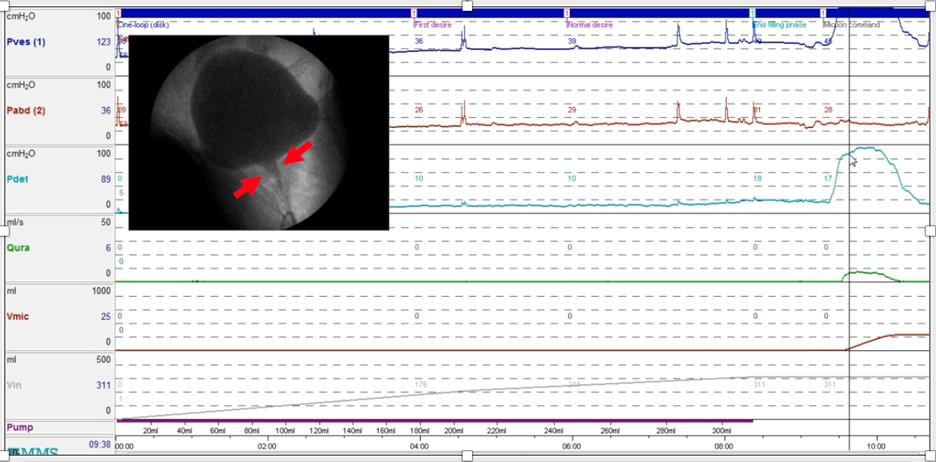




Dysfunctional voiding in adult women (and men) is a diagnosis plagued by poor quality of evidence that limits our ability to offer optimum care.
The current International Continence Society definition requires an ‘intermittent and/or fluctuating flow’ in the absence of a neurological condition (ICS Glossary). However, fluctuating flow is not universal leaving the rest without a diagnosis (Figure 1).

Figure 1: Video-urodynamics in an adult woman with refractory voiding difficulty and no anatomical narrowing showing high voiding pressure, slow (but steady rather than staccato) flow and a dilated proximal urethra (RED arrows) in the absence of any underlying neurological conditions on detailed neurological evaluation.
It is unclear exactly what is dysfunctional. Surface electromyography, video-urodynamics or urethral pressure profile do not differentiate between striated sphincter and pelvic floor dyssynergia and it’s probable that dysfunctional voiding encompasses a heterogenous group.
Literature often ascribes the condition to faulty toilet training, or an adverse childhood experience not noted in many adults. Do some of these represent unidentifiable subtle neurological insult? In some women, dysfunctional voiding may be associated with an overactive pelvic floor with chronic pelvic pain.
Relying on a staccato flow would lead to the exclusion of several women who turn out to have dysfunctional voiding on detailed invasive urodynamics. Invasive urodynamics is best offered early in the diagnostic algorithm of documented voiding abnormality in the absence of an anatomical cause. Use of video, urethral pressure profile or both should be recommended possibly at dedicated referral centers.
There is no good evidence that this therapy works in adults, no established protocols, no defined timelines for what should be done, how often and for how long leading to remarkable variations in practice. European Association of Urology Guidelines make a weak recommendation for this therapy in women with functional obstruction (Harding et. al., 2022), a tacit recognition that most women with ‘functional’ obstruction fail to get a satisfactory specific diagnosis.
The relationship between dysfunctional voiding and dyssynergic defecation remains unclear and some might be suffering from pelvic floor dysfunction. Although part of clinical care, it is uncertain how much benefit patients experience in their urinary symptoms specifically from the aggressive bowel care.
While often prescribed, it is unclear whether skeletal muscle relaxants really work, which ones are best and when (if at all) they should be discontinued. The same goes for alpha-adrenergic blockers.
The encouraging literature on intra-sphincteric botulinum toxin seems at variance with limited clinical use. In this author’s experience, women who are on intermittent catheterization seldom get off it. Reductions in voiding pressure may not be enough to render an unsafe bladder safe. The same goes for sacral (and other forms) of neuromodulation. Case series seem to combine a heterogeneous set of patients with voiding symptoms without a precise diagnosis. Good quality trials are missing.
This essay is a stunning rebuke for researchers in the field of functional urology. These issues have consequences for women who often fail to obtain appropriate therapy. A precise, unambiguous definition is the key to accumulating quality evidence. While many of this author’s views, evaluation protocols, and management options have evolved, earlier observations with regard to terminology remain relevant (Sinha 2011).
Dysfunctional voiding (women). International Continence Society Glossary. Available at: www.ics.org, accessed on September 4, 2022.
Harding CK, Lapitan MC, Arlandis S, Bo K, Costantini E, Groen J, Nambiar AK, Omar MI, Phe V, et al. Non-neurogenic Female LUTS. European Association of Urology Guidelines. 2022. Available at: https://uroweb.org/guideline/non-neurogenic-female-luts, accessed September 4, 2022.
Sinha S. Dysfunctional voiding: A review of the terminology, presentation, evaluation and management in children and adults. Indian J Urol. 2011 Oct;27:437-47.
![]() It is conceivable that women with a predominantly pelvic floor component to the dyssynergia leading to voiding difficulty would respond to biofeedback relaxation therapy. Hence, in the absence of any evidence-based method to distinguish the sphincter component from the pelvic floor one, do you agree with the contention that every woman should undergo biofeedback relaxation therapy with the caveat that all may not respond to it?
It is conceivable that women with a predominantly pelvic floor component to the dyssynergia leading to voiding difficulty would respond to biofeedback relaxation therapy. Hence, in the absence of any evidence-based method to distinguish the sphincter component from the pelvic floor one, do you agree with the contention that every woman should undergo biofeedback relaxation therapy with the caveat that all may not respond to it?
![]() Yes. Available evidence does not differentiate these underlying conditions.
Yes. Available evidence does not differentiate these underlying conditions.
![]() Are current diagnostics including video-urodynamics truly able to distinguish between primary bladder neck obstruction and pelvic floor-external sphincter dyssynergia in all patients?
Are current diagnostics including video-urodynamics truly able to distinguish between primary bladder neck obstruction and pelvic floor-external sphincter dyssynergia in all patients?
![]() Yes. In most women, these are distinct and unequivocal diagnoses. While uncommon, primary bladder neck obstruction does exist, and these women can benefit from a bladder neck incision.
Yes. In most women, these are distinct and unequivocal diagnoses. While uncommon, primary bladder neck obstruction does exist, and these women can benefit from a bladder neck incision.
![]() Do you think that classical Fowler's syndrome with all features described truly exists? Or should we modify the term to call it a Fowler's variant which just denotes a woman with a predominantly sphincter issue leading to the dysfunctional voiding?
Do you think that classical Fowler's syndrome with all features described truly exists? Or should we modify the term to call it a Fowler's variant which just denotes a woman with a predominantly sphincter issue leading to the dysfunctional voiding?
![]() I think Fowler’s syndrome is just one phenotype of women with a high-tone non-relaxing sphincter and the electromyographic findings originally described are not unique to the condition. I believe all these women should be categorized under the umbrella term ‘dysfunctional voiding’.
I think Fowler’s syndrome is just one phenotype of women with a high-tone non-relaxing sphincter and the electromyographic findings originally described are not unique to the condition. I believe all these women should be categorized under the umbrella term ‘dysfunctional voiding’.
![]() Many young women in their 20s with Fowler's variant often have a history of a milestone traumatic event in their adult life following which they have sudden development of symptoms. How do you think that the neurological response underlying this phenomenon can be researched? A learned behavior modification that can explain faulty toilet training or adverse childhood experience leading to dysfunctional voiding, does not seem to suffice as an explanation for the Fowler's variant that we see in our practice, given the sudden nature of symptom development.
Many young women in their 20s with Fowler's variant often have a history of a milestone traumatic event in their adult life following which they have sudden development of symptoms. How do you think that the neurological response underlying this phenomenon can be researched? A learned behavior modification that can explain faulty toilet training or adverse childhood experience leading to dysfunctional voiding, does not seem to suffice as an explanation for the Fowler's variant that we see in our practice, given the sudden nature of symptom development.
![]() I suspect dysfunctional voiding is a heterogeneous group of conditions encompassing external sphincter dyssynergia, pelvic floor dyssynergia and combined sphincter-pelvic floor dyssynergia owing to a variety of underlying disparate causes, including but not limited to, overactive pelvic floor, disturbance in the spinal reflexes by a triggering event or subtle neurological disease.
I suspect dysfunctional voiding is a heterogeneous group of conditions encompassing external sphincter dyssynergia, pelvic floor dyssynergia and combined sphincter-pelvic floor dyssynergia owing to a variety of underlying disparate causes, including but not limited to, overactive pelvic floor, disturbance in the spinal reflexes by a triggering event or subtle neurological disease.